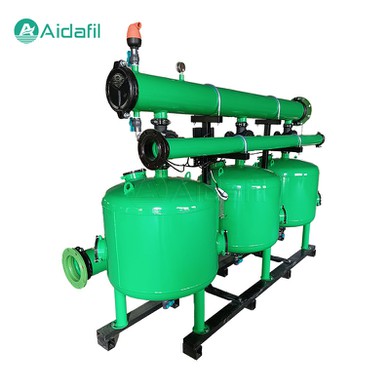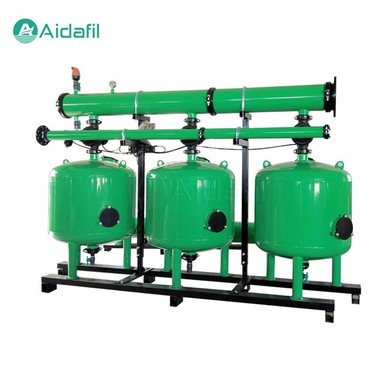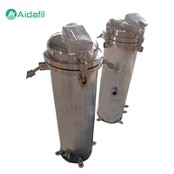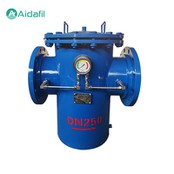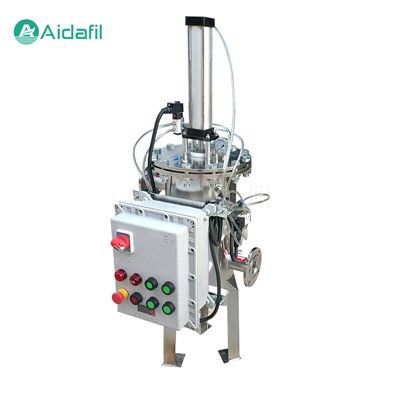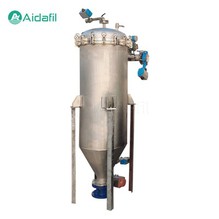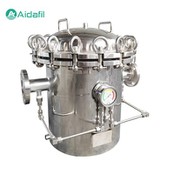
Well-Designed Low Cost Quartz Sand Filter
Product Details
The well-designed low cost quartz sand filter operates on the principle of physical filtration. It consists of a pressure vessel filled with layers of quartz sand, which serve as the filtering medium. The sand particles, typically ranging from 0.4 to 1.2 mm in diameter, form a porous structure that traps suspended solids and other contaminants as water passes through.
The filter's design is optimized to ensure efficient flow and minimal pressure drop. The sand bed is supported by a gravel layer at the bottom, which aids in distributing the incoming water evenly and preventing sand migration. An underdrain system collects the filtered water and directs it out of the filter. The top of the filter may include a distributor to evenly distribute the incoming water over the sand bed.
Main Technical Data
Working pressure : 0.05MPa~1.0MPa
Working temperature : 0°C~40°C
Flow : 0.5 m3/h~140 m3/h
Operation
The operation of the quartz sand filter is straightforward. Water with high turbidity enters the filter under pressure, typically from a pump or gravity feed. As the water flows downward through the sand bed, contaminants are trapped within the interstices between sand particles. The filtered water then exits the filter through the underdrain system.
Over time, the sand bed becomes clogged with trapped contaminants, reducing the filter's efficiency. To maintain performance, the filter undergoes a backwashing process, where clean water is forced upward through the sand bed, dislodging and flushing away the accumulated contaminants. The frequency of backwashing depends on the filter's loading rate and the quality of the influent water.
Design Considerations
The well-designed low cost quartz sand filter incorporates several key components to optimize filtration efficiency and durability while minimizing costs. These include:
1. Filter Media. High-quality quartz sand with uniform particle size distribution is essential for effective filtration. The selection of appropriate sand ensures optimal removal of impurities without excessive pressure drop.
2. Filter Bed Depth. The thickness of the sand bed influences filtration performance. A sufficient bed depth allows for adequate contact time between water and sand, enhancing particle capture efficiency.
3. Filter Structure. The design of the filter vessel should facilitate uniform distribution of water across the sand bed. Proper inlet and outlet configurations, along with adequate support structures, ensure consistent filtration throughout the entire bed depth.
4. Backwashing Mechanism. To maintain filter performance over time, periodic backwashing is necessary to remove accumulated solids from the sand bed. Well-designed filters incorporate efficient backwashing systems that minimize water and energy consumption.
Cost-Effectiveness
One of the primary advantages of the quartz sand filter is its low cost. Quartz sand is an abundant and inexpensive material, making it an economical choice for filtration media. Additionally, the filter's simple design requires minimal maintenance and has a long service life, further reducing operational costs.
The low cost of the quartz sand filter does not compromise its performance. It effectively removes suspended solids, organic matter, and some microorganisms, resulting in a significant reduction in water turbidity. This makes it suitable for a wide range of applications, from domestic water treatment to industrial processes.
Applications
The well-designed low cost quartz sand filter finds widespread applications across diverse industries, including:
1. Agriculture. In agricultural irrigation systems, quartz sand filters play a crucial role in removing sediment, organic matter, and other contaminants from water sources, thereby safeguarding crop health and optimizing water usage.
2. Chemical Industry. Within the chemical sector, quartz sand filters are employed for process water treatment, ensuring the purity of water used in various manufacturing processes and minimizing the risk of product contamination.
3. Petroleum and Mining. In oil refineries and mining operations, quartz sand filters contribute to the purification of water used for cooling, processing, and equipment maintenance, thus promoting operational efficiency and environmental compliance.
4. Metallurgy. Metallurgical processes often require large volumes of water for cooling and material handling. Quartz sand filters aid in the removal of suspended solids and impurities, supporting the production of high-quality metals and alloys.
FAQ
1. Q: What is the function of a filter?
A: The main function of a filter is to remove solid particles, impurities, and harmful substances from liquids or gases, in order to achieve purification, clarification, and protection of equipment.
2. Q: How to choose a suitable filter?
A: When choosing a filter, factors such as the properties of the material being filtered (e.g., viscosity, temperature, corrosion), required filtration accuracy, processing capacity, operating pressure and medium, as well as the type, material, size, and installation method of the filter should be considered.
3. Q: What is the working principle of a filter?
A: The working principle of a filter mainly relies on physical screening, deep interception, absorption, or chemical reactions to remove impurities or harmful components from the material being filtered.
4. Q: How to maintain and care for a filter?
A: Maintenance of filters includes regular cleaning or replacement of filter elements, inspection of seals and fasteners, maintaining stable operating pressure, and avoiding overloading. Specific methods should be referenced from the filter's instruction manual and maintenance guides.
5. Q: What is the service life of a filter?
A: The service life of a filter depends on its working environment, processing volume, and filtration accuracy. Generally, when the filter's pressure drop reaches a certain value or the filtration effect decreases significantly, it needs to be replaced or cleaned.
6. Q: What should be paid attention to during filter installation?
A: During filter installation, attention should be paid to the directionality, ensuring that the fluid enters and exits from the correct ports. Also, the piping system should be cleaned before installation, and the filter should be securely fastened and sealed as required by the instructions.
7. Q: What is the replacement cycle for filters?
A: The replacement cycle for filters depends on their working conditions and filtration requirements, and is usually indicated by pressure difference indicators or timers. When the filter's pressure drop reaches the set value or the filtration effect decreases, it should be replaced in a timely manner.
Why Choose Us
· Professional manufacturer with many years' experience
· Good quality with competitive price
· OEM & ODM are welcome
· Various payment items are acceptable
· Good service by experienced manager
AIDA Philosophy
1. Management Concept:
· Satisfy the customers' demand --- Touch customers, trust with our products and services
· Make employees happy --- Pursue higher material and spiritual happiness
2. Company Mission:
· Focus on customer needs, provide best filtering solution
· To be the lifelong partner with customers
3. Corporate Vision:
· Become a global purification leadership brand
4. Values:
· Customer: Pursue the ultimate experience, enjoy excellent quality
· Team: Trust, responsibility, growth, win-win
· Work: Simple, sincere, efficient, dedicated
Hot Tags: well-designed low cost quartz sand filter, China, factory, price, buy, 200 micron transformer oil filter cartridge, Air Oil Separator, 100um basket strainer, high flow rate automatic backwash filter, Filter Housing, industrial oil filter in lubricating

